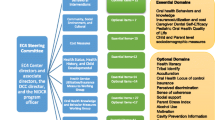Abstract
To examine what sources of health information are preferred by first-time mothers-to-be and how these preferences change by the time their child reaches school age. Women expecting their first child (n = 649), recruited in a randomized trial of early childhood caries prevention at all five public maternity hospitals in Adelaide, were questioned about their preferences for health information. Their preferences were assessed again 4 and 7 years later. Answers at 7 years were compared with those of a population-based cohort of mothers with a first child of the same age. Parents were listed most frequently as a preferred source of health information during pregnancy (67.8%) followed by health care practitioners (48.8%). By the time the child reached school age, 78% listed health care practitioners as their preferred source compared with 15.5% listing parents, 21.7% friends and relatives, and 13% the Internet. Data from the population-based comparison group of mothers with a first child of similar age mimicked those of mothers enrolled in the trial. Mothers put a lot more trust in information received from health care professionals than they did before their child was born. This can create opportunities for enhancing the effectiveness of community health initiatives.
Similar content being viewed by others
References
Kummervold, P. E., Chronaki, C. E., Lausen, B., Prokosch, H. U., Rasmussen, J., Santana, S., et al. (2008). eHealth trends in Europe 2005–2007: A population-based survey. Journal of Medical Internet Research, 10, e42.
Jadad, A. R., & Gagliardi, A. (1998). Rating health information on the Internet. Journal of the American Medical Association, 279, 611–614.
Eysenbach, G., Powell, J., Kuss, O., & Sa, E. R. (2002). Empirical studies assessing the quality of health information for consumers on the world wide web: A systematic review. Journal of the American Medical Association, 287, 2691–2700.
McInnes, N., & Haglund, B. J. (2011). Readability of online health information: Implications for health literacy. Informatics for Health & Social Care, 36(4), 173–189.
Rossow, I., & Rise, J. (1994). Concordance of parental and adolescent health behaviors. Social Science and Medicine, 38, 1299–1305.
Greenberg, R. S., Ariza, A. J., & Binns, H. J. (2010). Activity and dietary habits of mothers and children: Close ties. Clinical Pediatrics, 49, 1026–1032.
Campbell, K., Hesketh, K., Silverii, A., & Abbott, G. (2010). Maternal self-efficacy regarding children’s eating and sedentary behaviours in the early years: Associations with children’s food intake and sedentary behaviours. International Journal of Pediatric Obesity, 5, 501–508.
Nowak, A. J., & Casamassimo, P. S. (1995). Using anticipatory guidance to provide early dental intervention. Journal of the American Dental Association, 126, 1156–1163.
Australian Institute of Health and Welfare. (2000). Australian hospital statistics 1998–1999; Health services series no. 15, cat.no.HSE-11. Canberra: Australian Government Publishing Services.
Armfield, J. M., Spencer, A. J. & Brennan, D. S. (2009). Dental health of Australia’s teenagers and pre-teen children: The Child Dental Health Survey, Australia 2003–2004. Dental statistics and research series no. 52, Cat no. DEN 199. Canberra: AIHW.
Plutzer, K., & Spencer, A. J. (2008). Efficacy of an oral health promotion intervention in the prevention of early childhood caries. Community Dentistry and Oral Epidemiology, 36, 335–346.
Cotton, S. R., & Gupta, S. S. (2004). Characteristics of online and offline health information seekers and factors that discriminate between them. Social Science and Medicine, 59, 1795–1806.
Hesse, B. W., Nelson, D. E., Kreps, G. L., Croyle, R. T., Arora, N. K., Rimer, B. K., et al. (2005). The impact of the Internet and its implication for health care providers: Findings from the First Health Information National Trends Survey. Archives of Internal Medicine, 165, 2618–2624.
Keatinge, D. (2006). Parents’ preferred child health information sources: Implications for nursing practice. Australian Journal of Advanced Nursing, 23, 13–18.
Lawson, R., Forbes, S., & Williams, J. (2011). Patterns of trust in sources of health information. New Zealand Medical Journal, 124, 98–105.
Percheski, C., & Hargittai, E. (2011). Health information-seeking in the digital age. Journal of American College Health, 59, 379–388.
Pettit, M. L., Kittleson, M. J., Brown, S. L. & Ritzel, D. O. (2007). An assessment of preferred health information sources among college students and GED candidates. AAHPERD National Convention and Exposition, Baltimore, March 13–17, 2007.
Raynes-Greenow, C. H., Nassar, N., & Roberts, C. L. (2008). Residential mobility in a cohort of primiparous women during pregnancy and post-partum. Australian and New Zealand Journal of Public Health, 32, 131–134.
Wen, L. M., Rissel, C., Baur, L. A., Lee, E., & Simpson, J. M. (2011). Who is NOT likely to access the Internet for health information? Findings from first-time mothers in southwest Sydney, Australia. International Journal of Medical Informatics, 80, 406–411.
McMullan, M. (2006). Patients using the internet to obtain health information: How this affects the patient-health professional relationship. Patient Education and Counseling, 63, 24–28.
Schwartz, K. L., Roe, T., Northrup, J., Meza, J., Seifeldin, R., & Neale, A. V. (2006). Family medicine patients’ use of the Internet for health information: A MetroNet study. Journal of the American Board of Family Medicine, 19, 39–45.
Acknowledgments
We are indebted to Professor A. John Spencer of the Australian Research Centre for Population Oral Health for guidance and to Dr. Andrew Chartier and Andrew Hall of the South Australian School Dental Service for constructing the comparison group. We also thank the mothers who participated in the study. This study was supported by NHMRC Centre of Clinical Research Excellence, Adelaide, South Australia.
Author information
Authors and Affiliations
Corresponding author
Rights and permissions
About this article
Cite this article
Plutzer, K., Keirse, M.J.N.C. Effect of Motherhood on Women’s Preferences for Sources of Health Information: A Prospective Cohort Study. J Community Health 37, 799–803 (2012). https://doi.org/10.1007/s10900-011-9513-0
Published:
Issue Date:
DOI: https://doi.org/10.1007/s10900-011-9513-0




